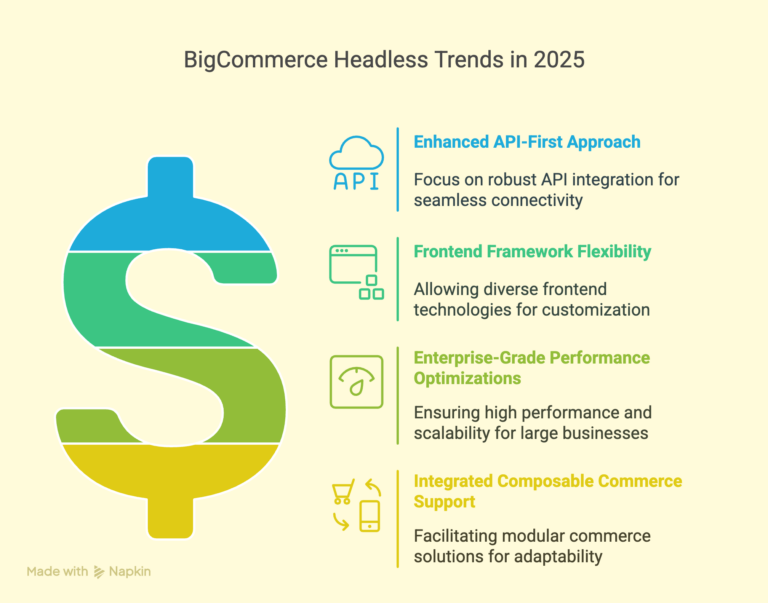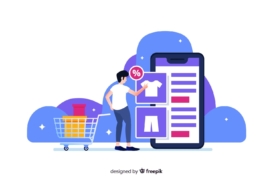Greetings! I'm Aneesh Sreedharan, CEO of 2Hats Logic Solutions. At 2Hats Logic Solutions, we are dedicated to providing technical expertise and resolving your concerns in the world of technology. Our blog page serves as a resource where we share insights and experiences, offering valuable perspectives on your queries.

Quick Summary
BigCommerce is cementing its position in the 2025 headless commerce landscape through enhanced API capabilities, expanded frontend framework support, and enterprise-focused solutions. While facing strong competition from composable commerce platforms, BigCommerce’s balance of flexibility and ease-of-use makes it particularly attractive for mid-market businesses transitioning to headless architecture.
Ever felt overwhelmed trying to keep up with the rapidly evolving headless commerce landscape? You’re not alone.
As we navigate through 2025, headless commerce continues to reshape how businesses approach their digital storefronts, and BigCommerce is right in the middle of this transformation.
Let’s dive into what’s happening in the headless commerce space and evaluate where BigCommerce stands among the competition.
What’s Driving Headless Commerce in 2025?
The headless commerce movement continues to gain momentum in 2025, driven by several key factors:
- Increasing demand for personalized experiences
- The need for lightning-fast page loads
- Omnichannel commerce requirements
- Greater developer flexibility
BigCommerce headless solutions have evolved significantly to address these demands, particularly for businesses looking to break free from traditional monolithic platforms without completely rebuilding their tech stack.
Top BigCommerce Headless Trends in 2025

1. Enhanced API-First Approach
BigCommerce has doubled down on its API-first strategy in 2025, significantly expanding its catalogue of APIs and microservices.
This expansion allows businesses to build truly unique frontend experiences while leveraging BigCommerce’s robust backend capabilities.
What’s notable about BigCommerce’s headless implementation in 2025:
- GraphQL API enhancements with improved performance metrics
- Expanded webhook capabilities for real-time data synchronization
- Microservices architecture that allows for modular implementation
In our experience working with clients at 2HatsLogic, these API improvements have dramatically reduced development time while enabling more sophisticated customer experiences.
2. Frontend Framework Flexibility
One area where BigCommerce has made tremendous strides is in supporting modern frontend frameworks.
While they’ve long supported React-based implementations, 2025 has seen expanded support for:
- Vue.js integration
- Angular compatibility
- Enhanced Next.js support
- Native support for headless CMS integration
This flexibility allows development teams to work with tools they’re already comfortable with rather than learning entirely new systems.
3. Enterprise-Grade Performance Optimizations
BigCommerce headless implementations in 2025 are showing impressive performance metrics compared to traditional setups.
Let’s look at the data:
| Metric | Traditional BigCommerce | Headless BigCommerce | Improvement |
|---|---|---|---|
| Page Load Time | 2.8 seconds | 0.9 seconds | 68% faster |
| Time to First Byte | 320ms | 95ms | 70% faster |
| Conversion Rate | Baseline | +22% | Significant |
| Developer Velocity | Baseline | +40% | Substantial |
These performance improvements translate directly to better user experiences and higher conversion rates for businesses implementing BigCommerce headless solutions.
Pro-tip: When implementing a BigCommerce headless solution, invest time in proper caching strategies. Our agency has seen up to 30% additional performance gains by implementing strategic edge caching for product and category data.
4. Integrated Composable Commerce Support
Perhaps the most significant BigCommerce headless trend of 2025 is the platform’s embrace of composable commerce principles.
Rather than positioning headless as simply “decoupling the frontend,” BigCommerce now offers:
- Pre-built integrations with best-of-breed services
- Composable checkout experiences that can be customized for different markets
- Modular backend services that can be implemented selectively
This approach strikes a balance between the flexibility of fully composable commerce and the convenience of an integrated platform.
Ready to future-proof your commerce strategy with BigCommerce headless?
BigCommerce Headless Compared to Competitors in 2025
The headless commerce landscape is more competitive than ever in 2025. Here’s how BigCommerce stacks up against key players:
Commercetools: The Pure Composable Leader
Commercetools remains the gold standard for enterprise-level composable commerce. Compared to BigCommerce headless solutions:
- Commercetools: Offers ultimate flexibility but requires significant development resources
- BigCommerce: Provides a balance of flexibility and out-of-the-box functionality
For large enterprises with substantial development resources, commercetools may still be the preferred choice.
However, BigCommerce has gained ground by offering comparable flexibility with less implementation complexity.
Shopify Hydrogen: The Developer Favorite
Shopify’s Hydrogen framework has matured considerably by 2025, offering:
- Strong React-based developer experience
- Integrated hosting with Oxygen
- Streamlined deployment processes
BigCommerce headless implementations still provide more flexibility for complex business requirements, particularly for B2B scenarios, but Hydrogen offers a more streamlined developer experience for straightforward D2C implementations.
Elastic Path: The B2B Specialist
For complex B2B implementations, Elastic Path continues to be a strong competitor to BigCommerce headless solutions, particularly excelling in:
- Complex pricing structures
- Account hierarchies
- Quote management
BigCommerce has strengthened its B2B capabilities in 2025, but specialized B2B requirements might still favor Elastic Path in certain scenarios.
Transform your digital storefront with expert-led BigCommerce headless implementation
Implementation Strategies for BigCommerce Headless in 2025
Based on our experience at 2HatsLogic, here are the most successful approaches to implementing BigCommerce headless commerce in 2025:
1. The Incremental Approach
Rather than a complete replatform, many businesses are finding success with an incremental approach to BigCommerce headless implementation:
- Start with headless storefronts for key landing pages
- Gradually expand to product detail and category pages
- Implement headless checkout as the final phase
This approach minimizes risk while allowing businesses to realize benefits quickly.
2. Composable Frontend Strategy
The most successful BigCommerce headless implementations in 2025 are taking a composable approach to the frontend as well:
- Micro-frontends for different sections of the site
- Specialized UIs for different user segments
- Progressive enhancement for different devices
This strategy allows teams to iterate quickly on specific sections of the site without rebuilding the entire frontend.
3. Performance-First Development
With user expectations continually rising, successful BigCommerce headless implementations in 2025 prioritize performance above all:
- Implementing edge computing for dynamic content
- Utilizing static generation where possible
- Strategically caching API responses
At 2HatsLogic, we’ve seen conversion improvements of 15-30% simply by focusing on these performance optimizations in BigCommerce headless implementations.
Pro-Tip: Don’t overlook the importance of analytics in your headless implementation. Traditional analytics tools often break in headless setups. Implement a robust server-side analytics solution from day one to ensure you’re capturing accurate data.
Common Challenges with BigCommerce Headless in 2025
Despite the platform’s advances, certain challenges remain when implementing BigCommerce headless commerce:
1. Development Complexity
While BigCommerce has simplified many aspects of headless implementation, it still requires more development resources than traditional approaches. Businesses need to be prepared for:
- Higher initial development costs
- More specialized developer skills
- Ongoing maintenance requirements
2. Analytics and Tracking
Headless implementations continue to present challenges for traditional analytics tools. Businesses implementing BigCommerce headless solutions should plan for:
- Server-side analytics implementation
- Custom event tracking
- Potential gaps in historical data comparison
3. Content Management Workflow
Without proper planning, content management can become more complex in a headless environment. Successful implementations typically include:
- Integration with a headless CMS
- Clear workflows for content authors
- Preview capabilities for unpublished content
Future of BigCommerce Headless Beyond 2025
Looking ahead, several emerging trends will likely shape the evolution of BigCommerce headless commerce:
- AI-driven personalization is natively supported in the headless API layer
- Edge computing capabilities are built directly into the platform
- Enhanced B2B functionality specifically designed for headless implementations
- Simplified deployment processes to reduce technical barriers
BigCommerce appears well-positioned to adapt to these trends, particularly as they continue to invest in their API-first approach.
Is BigCommerce Headless Right for Your Business?
Based on our experience implementing dozens of headless solutions at 2HatsLogic, BigCommerce headless commerce is particularly well-suited for:
- Mid-market retailers looking to improve site performance
- B2B businesses with complex product catalogs
- Multi-brand companies need consistent backend systems
- International businesses require localized experiences
The ideal candidate has sufficient technical resources but wants to avoid the complexity of a fully custom solution.
Conclusion: BigCommerce’s Position in the 2025 Headless Landscape
As we navigate through 2025, BigCommerce has firmly established itself as a strong contender in the headless commerce space.
BigCommerce offers an appealing balance of flexibility, functionality, and ease of implementation. BigCommerce headless solutions provide a pragmatic path forward with demonstrable benefits in performance, developer experience, and business outcomes.
Ready to explore how a BigCommerce headless implementation could transform your business? Contact our team at 2HatsLogic for a free consultation on how we can help you navigate the headless commerce landscape.
FAQ
Is BigCommerce headless suitable for small businesses?
While technically possible, BigCommerce headless implementations typically require more development resources than traditional setups. Small businesses should carefully evaluate if they have the technical resources to support a headless architecture before proceeding.
How does BigCommerce headless compare to Shopify headless?
BigCommerce offers more flexibility and better B2B capabilities in their headless implementation compared to Shopify. However, Shopify's Hydrogen framework provides a more streamlined developer experience for straightforward D2C use cases.
What are the main benefits of implementing BigCommerce headless commerce?
The primary benefits include improved site performance, greater frontend flexibility, better developer experience, and the ability to deliver truly omnichannel customer experiences while maintaining BigCommerce's robust backend capabilities.
Table of contents
- What's Driving Headless Commerce in 2025?
- Top BigCommerce Headless Trends in 2025
- BigCommerce Headless Compared to Competitors in 2025
- Implementation Strategies for BigCommerce Headless in 2025
- Common Challenges with BigCommerce Headless in 2025
- Future of BigCommerce Headless Beyond 2025
- Conclusion: BigCommerce's Position in the 2025 Headless Landscape

Related Articles






